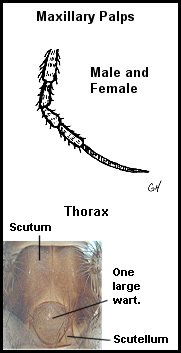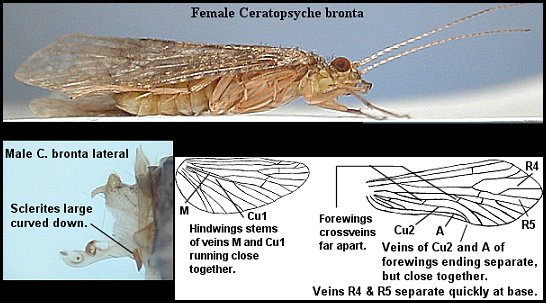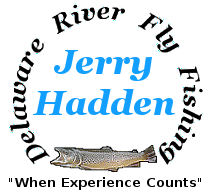
Order Trichoptera
Family Hydropsychidae
Genus Ceratopsyche
Species bronta


Pronounced - sir ah to si kee - bron ta
Common Name - Spotted Sedge
Size
Hook - 16, 18
Millimeter - 9 to 11
Type - Common net spinner
Case Type - None
Adult
Body Color - Tan thorax with abdominal colors ranging from pale olive with a tanish tinge, to olive with a tanish yellow tinge, with a grayish tint laterally, most are darker in color than C. slossonae, and C. sparna.
Wing Color - Medium to dark Dun covered with brown hair, and tan spots, when freshly hatched wings are light to medium dun with a yellowish stain on the wings basal section.
Morse (1993) listed twenty-six species in North America (Moulton & Johnson 1996).
Ceratopsyche larvae spin silk into nets not unlike a spider spins a web to collect insects.
Ceratopsyche feed upon plant particles, smaller insects, and debris collected in their nets from the flowing water.
Ceratopsyche larvae don't build cases, but build a retreat near their nets camouflaged with small gravel, and plant debris.
By far the most important spicies of Ceratopsyche, producing large hatches from mid May to early September. During the hatch adults swim, or more like run very quickly to the rivers surface. I've observed this running during hatches, and the direction is almost always towards the shoreline.
Key to Family - Ocelli absent. Legs - spurs foreleg 2, middle 4, hind 4. One large wart on scutellum. Both male and female maxillary palps are five segmented, segment five is long, flexible, and whip like.
Key to Genus - Forewings - veins R4 and R5 separateing quickly at their base, crossveins M3+4-Cu1 and Cu1-Cu2 located far apart, veins Cu2 and A ending separately, but close together. Stems of M and Cu veins of hindwing running close together, and parallel throughout their length.
Key to Species - C. bronta - Male, sclerites large cylindrical and held down, well below phallobase. Modified from, Moulton and Johnson - 1996 - Interior Highlands Trichoptera Memoirs of the American Entomological Institute 56.
Jerry Hadden's Guide Service
Fly fishing float trips for wild trout on the Upper Delaware River.
607-221-4282


